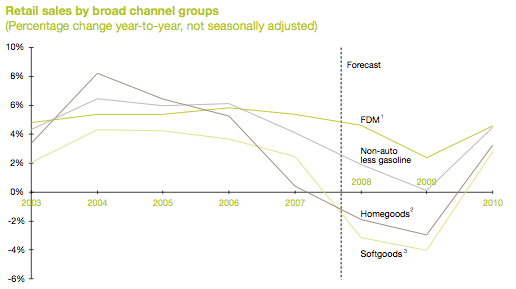After a relatively uplifting February, it was disappointing for many to see the sales numbers for March. Retail sales decreased 0.6% seasonally adjusted from February and dropped 3.7% unadjusted over 2008, according to the National Retail Federation. “I think the March numbers were a surprise for everyone,” notes Paula Rosenblum, analyst for Retail Systems Research (RSR).
In part, March’s lower sales could be attributed to a colder-than-usual spring and a late Easter holiday. But a deeper look into the numbers shows some bright spots. Certain retail segments recorded a smaller loss than expected and other retailers posted slight gains. “The ‘value’ retailers continue to do well,” says Rosenblum. Walmart and Costco posted gains in same-store sales for March, as well as BJ’s Wholesale Club and Family Dollar Stores. Health and personal care retailers also fared well in March, up 3.5% unadjusted over 2008, NRF reports. Food and beverage stores were also up, 1.8% unadjusted year-over-year.
Looking beyond the month-to-month changes, the industry may need to alter its perspective on the numbers and how to react to them. “What people fail to realize is that overall retail sales remain literally at 2007 levels, which is up 20% from 2001,” notes Greg Buzek, president, IHL Consulting. “What has changed is the distribution of where the money is being spent. It really comes down to Needs, Wants and Desires. The Needs business is doing pretty well, with revenues flat to up in most cases. The Wants category will begin to see a recover I think as early as May/June of this year. The Desires group I don’t see recovering until 2010 at the earliest.”
However retailers define the current sales trends, one fact is constant: the consumer is changing and the retail industry needs to change with the consumer in order to survive and thrive. “Retailers must understand consumers’ trip mission behavior and develop a framework to respond to it,” says George Lawrie, principal analyst, Forrester Research. “More savvy retailers are preparing for multichannel retailing, making investments that will help to ensure that they increase market share as more price and promotion sensitive consumers conduct more intensive web research before buying anything.”
Current and Future Retail Trends
Trends are changing. The retail industry is no longer a push environment controlled by marketers – it is now controlled by the demands of the consumers. In a March 2009 report titled “How will this recession affect the future of retailing?”, sponsored by PricewaterhouseCoopers (PwC), TNS Retail Forward predicts the Top 15 trends for retailing, looking ahead to 2015:
- The downsizing of (almost) everything – including packaging, store footprint and growth expectations.
- The localization of retailing – defined as tailoring existing stores to specific customer segments and local markets.
- Breaking the 80/20 rule – as retailers turn to limited editions and smaller runs to build shopper excitement and generate stronger full-price sell-throughs.
- The unchaining of retailing – as chain size tops out, retailers will rely on new concepts for sales growth
- Global consolidation of big-box retailers – by 2015 the world’s largest retailers are expected to increase their global presence through acquisition and organic growth.
- Share of life retailing – many retailers are adding complementary categories to their inventory.
- The “un-storing” of retailing – retailers must become channel agnostic to meet consumer demand
- The rise of the anchor place – mixed-use centers are poised to become the norm, no longer relying on an anchor store.
- Consumer as co-creator – more consumers will be actively engaged in product creating, planning and packaging
- Exclusivity escalates – private brands are becoming more popular.
- Suppliers defend turf – innovative distribution strategies will emerge as suppliers and retailers work together.
- Power to the people – mobile phones and social networking is giving consumers anytime access to retail information.
- New technological environment – technology will help consumers enjoy a more personalized and mobile shopping experience
- Value chain evolution – the new value chain will support niche merchandising
- Triple bottom line scorecard – retailers and suppliers must become better global citizens and will be judged on environmental, social and financial performance.
The future of retail technology
In the short-term retailers are focused on using their technology assets to create efficiencies and cut costs. In the longer term marketers must find the best ways to analyze and utilize customer data to customize and individualize product offerings, as well as prepare for a more mobile consuming public.
“Demand-based management can succeed only with real-time data information delivered through increasingly newer forms of technology delivery systems. As a result, retailing will become more personal, and customer data and relationships will become a key asset for retailers,” according to TNS Retail Forward/PricewaterhouseCoopers in the report “Retail 2015: New Frontiers.”
To respond to constant change and uncertainly, more retailers may turn to outsourcing, or cloud computing, as their primary source of IT systems, says Greg Buzek. “Retail is the ideal industry for cloud computing as we have peak periods of tremendous IT needs, but mostly slower periods. Certain systems are critical to keep in house, but much is not. That is the focus each retailer needs to look at.”
Survival of the smartest
Taking into account the changeability of sales, the uncertainty of the economy and the new demands of today’s consumers, the retailers who will rise to the top are those that have the fortitude to stick with their long-term strategies. “Retailers who stay the course strategically, tactically and surgically keep inventories and expenses low, and continue focusing on their customers are likely to come out on top,” says Rosenblum.
The retailers who panic and are not able to adapt to change are at risk. “A significant number of retailers are thrashing – running low on cash, eschewing investments and basically running scared – cost-cutting with a hatchet instead of a scalpel. They are in danger,” says Rosenblum. She adds: “Those who think customer-centricity is dead will fail.













